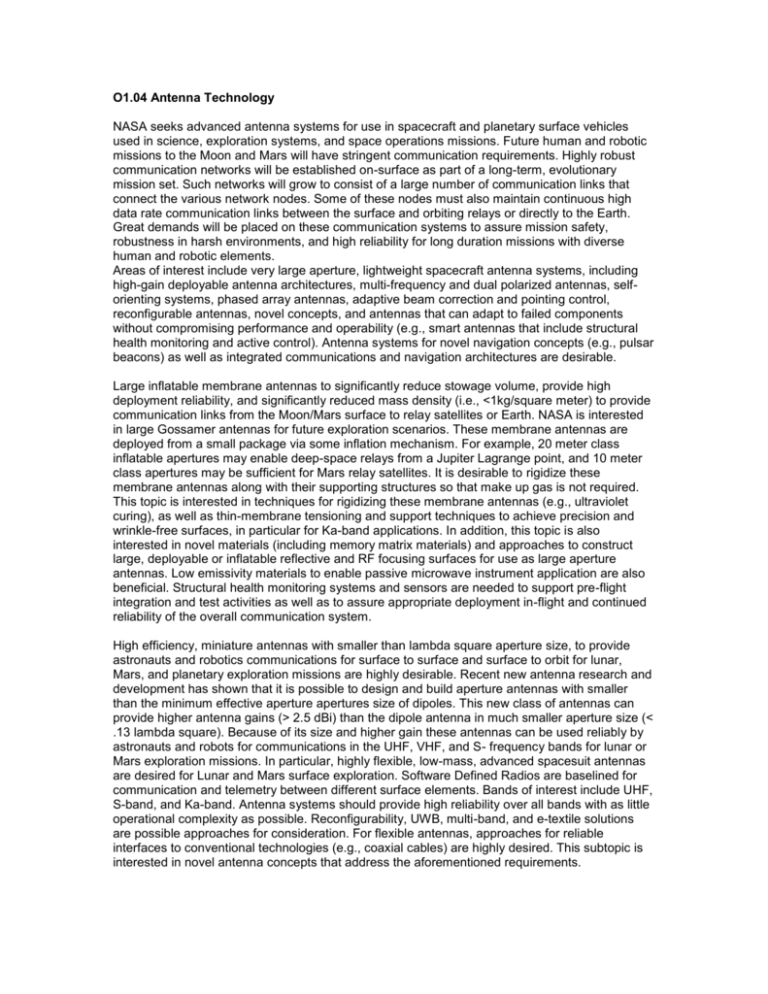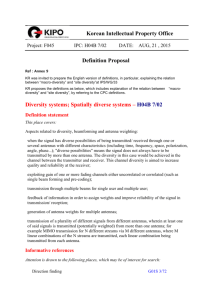Document
advertisement

O1.04 Antenna Technology NASA seeks advanced antenna systems for use in spacecraft and planetary surface vehicles used in science, exploration systems, and space operations missions. Future human and robotic missions to the Moon and Mars will have stringent communication requirements. Highly robust communication networks will be established on-surface as part of a long-term, evolutionary mission set. Such networks will grow to consist of a large number of communication links that connect the various network nodes. Some of these nodes must also maintain continuous high data rate communication links between the surface and orbiting relays or directly to the Earth. Great demands will be placed on these communication systems to assure mission safety, robustness in harsh environments, and high reliability for long duration missions with diverse human and robotic elements. Areas of interest include very large aperture, lightweight spacecraft antenna systems, including high-gain deployable antenna architectures, multi-frequency and dual polarized antennas, selforienting systems, phased array antennas, adaptive beam correction and pointing control, reconfigurable antennas, novel concepts, and antennas that can adapt to failed components without compromising performance and operability (e.g., smart antennas that include structural health monitoring and active control). Antenna systems for novel navigation concepts (e.g., pulsar beacons) as well as integrated communications and navigation architectures are desirable. Large inflatable membrane antennas to significantly reduce stowage volume, provide high deployment reliability, and significantly reduced mass density (i.e., <1kg/square meter) to provide communication links from the Moon/Mars surface to relay satellites or Earth. NASA is interested in large Gossamer antennas for future exploration scenarios. These membrane antennas are deployed from a small package via some inflation mechanism. For example, 20 meter class inflatable apertures may enable deep-space relays from a Jupiter Lagrange point, and 10 meter class apertures may be sufficient for Mars relay satellites. It is desirable to rigidize these membrane antennas along with their supporting structures so that make up gas is not required. This topic is interested in techniques for rigidizing these membrane antennas (e.g., ultraviolet curing), as well as thin-membrane tensioning and support techniques to achieve precision and wrinkle-free surfaces, in particular for Ka-band applications. In addition, this topic is also interested in novel materials (including memory matrix materials) and approaches to construct large, deployable or inflatable reflective and RF focusing surfaces for use as large aperture antennas. Low emissivity materials to enable passive microwave instrument application are also beneficial. Structural health monitoring systems and sensors are needed to support pre-flight integration and test activities as well as to assure appropriate deployment in-flight and continued reliability of the overall communication system. High efficiency, miniature antennas with smaller than lambda square aperture size, to provide astronauts and robotics communications for surface to surface and surface to orbit for lunar, Mars, and planetary exploration missions are highly desirable. Recent new antenna research and development has shown that it is possible to design and build aperture antennas with smaller than the minimum effective aperture apertures size of dipoles. This new class of antennas can provide higher antenna gains (> 2.5 dBi) than the dipole antenna in much smaller aperture size (< .13 lambda square). Because of its size and higher gain these antennas can be used reliably by astronauts and robots for communications in the UHF, VHF, and S- frequency bands for lunar or Mars exploration missions. In particular, highly flexible, low-mass, advanced spacesuit antennas are desired for Lunar and Mars surface exploration. Software Defined Radios are baselined for communication and telemetry between different surface elements. Bands of interest include UHF, S-band, and Ka-band. Antenna systems should provide high reliability over all bands with as little operational complexity as possible. Reconfigurability, UWB, multi-band, and e-textile solutions are possible approaches for consideration. For flexible antennas, approaches for reliable interfaces to conventional technologies (e.g., coaxial cables) are highly desired. This subtopic is interested in novel antenna concepts that address the aforementioned requirements. There is also interest in space-to-surface links at 25.5 GHz and 37 GHz. The size of reflector antennas is limited by the accuracy of the reflector surface that can be achieved and maintained on-orbit. Development of special materials and structural techniques to control their environment, etc., reduces environmentally induced surface errors and increases the maximum useable reflector size. Distortions caused by thermal gradients are inherently a large scale phenomenon. The reflector surface is usually sufficiently accurate over substantially large local areas but these areas are not on the same desired parabolic surface. An array of feed elements can be designed to illuminate the reflector with a distorted spherical wave. This distortion can be used to compensate for large scale surface error introduced by thermal gradients, gravitational and other forces, as well as manufacturing. Topics of interest include but are not limited to: Compensating Feed System for an Antenna Reflector Surface With Large Scale Distortions; Techniques for the remote Measurement of Satellite Antenna Profile Errors; Determination of Orbiting S/C Antenna Distortion by Ground-Based Measurements; Measuring and Compensating Antenna Thermal Distortions; Reflector Measurements and Corrections using arrays; and Reflector Distortion Measurement and Compensation Using Array Feeds. NASA is interested in low cost phased array antennas for suborbital vehicles such as sounding rockets, balloons, UAV's, and expendable vehicles. The frequencies of interest are S-band, Kuband, and Ka-band. The arrays are required to be aerodynamic in shape for the sounding rockets, UAV's, and expendable platforms. The balloon vehicles primarily communicate with TDRS and can tolerate a wide range of mechanical dimensions. Antenna pointing techniques and technologies for Ka-band spacecraft antennas that can provide spacecraft knowledge with sub-milliradian precision (e.g., <250 micro-radians) in order to point large spacecraft antennas (e.g., 10 meter diameter) at Mars are also desirable under this subtopic. Methods of dealing with extreme latency (e.g., 20 minutes) in beacon and monopulse systems are of interest. NASA is designing arrays of ground-based antennas to serve the telecommunications needs of future space exploration. Medium-size (12m class) antennas have been selected for receiving, and arrays of hundreds of them are expected to be required. Applications include communication with distant spacecraft; radar studies of solar system objects; radio astronomy; and perhaps other scientific uses. A significant challenge is the implementation of an array for transmitting (uplinking), which may or may not use the same antennas that are used for receiving. The uplink frequency will be in the 7.1 - 8.6 GHz range (X-band) in the near term, and may be in the 31.5 33.0 GHz band (Ka-Band) in the future; it will likely carry digital modulation at rates from 10 kbps to 30 Mbps. An EIRP of at least 500 GW is required, and some applications contemplate an EIRP as high as 10 TW. It is also desirable to support as many as ten simultaneously-operating deepspace missions from one complex on Earth, and to have at least three geographically separated complexes so communication is possible with a given spacecraft at any time of the day. The major challenges in the uplink array design are: Minimizing the life-cycle cost of an array that produces a given EIRP by selecting the optimum combination of antenna size, transmitter power, and number of antennas. This becomes much more difficult if the option of using the same antenna for both uplink and downlink is considered. Identifying/developing low-cost, highly reliable, easily serviceable components for key systems. This could include highly integrated RF and digital signal processing electronics, including mixed-signal ASICs. It could also include low-cost, high-volume antenna manufacturing techniques. (For the receiving array, another key component is a cryogenic refrigerator for the 15 - 25K temperature range.) Also, low-cost transmitters, including medium-power of the order of 100's of watts amplifiers, are desirable. Phase calibration techniques are required to ensure coherent addition of the signals from individual antennas at the spacecraft. It is important to understand whether space-based techniques are required or ground-based techniques are adequate. In general, a target spacecraft in deep space cannot be used for calibration because of the long round-trip communication delay. Design of ultra phase-stable electronics to maintain the relative phase among antennas. These will minimize the need for continuous, extensive and/or disruptive calibrations. Understanding the effect of the medium (primarily the Earth's troposphere) on the coherence of the signals at the target spacecraft. Generally, turbulence in the medium tends to disrupt the coherence in a way that is time-dependent and site-dependent. A quantitative understanding of this is needed. Techniques for integrating a very low-noise, cryogenically-cooled receiver with a medium power (1W to 200W) transmitter. If transmitters and receivers are combined on the same antenna, the performance of each should be compromised as little as possible, and the low cost and high reliability should be maintained. Research should be conducted to demonstrate technical feasibility during Phase 1 and it should show a path toward a Phase 2 hardware demonstration that will, when appropriate, deliver a demonstration unit for testing at the completion of the Phase 2 contract.



